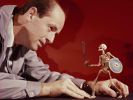Eye For Film >> Movies >> Ray Harryhausen: Special Effects Titan (2011) Film Review
For more than one generation of cinemagoers, the name Ray Harryhausen immediately conjures up nostalgic memories of stop-motion dinosaurs, mythical creatures, flying saucers and sword-wielding skeletons. The life and work of the special effects artist is celebrated in fittingly reverential fashion in Gilles Penso's newly released documentary, Ray Harryhausen: Special Effects Titan.
Now closing in on the ripe old age of 93, Harryhausen's place in cinema history is richly deserved, such was the technical skill, imagination and sheer love of creation the man brought to all of the projects he was involved with. That the line-up of interviewees in the documentary paying tribute to Harryhausen's influence on their own imaginations, films and effects work includes James Cameron, Steven Spielberg, Phil Tippett, Nick Park, John Landis and Joe Dante, to name but a few, is further measure of his enduring impact. Add to that, the fact that the fees for the clips were waved by all of the individual rights holders and the esteem the genial, self-effacing Harryhausen is held in is plain to see.

A straightforward, talking-head documentary, spliced with film sequences, dailies, test shots and newly released on-set footage, Penso's film is a treat; loving, illuminating and constantly entertaining. Featuring interviews with Harryhausen conducted over a five-year time span, Special Effects Titan runs chronologically through his career, from its inception (inspired by the stop motion work of Willis O'Brien in King Kong [1933]), through to Clash Of The Titans in 1981, after which Harryhausen retired. The pertinent thing to remember is that It Came From Beneath the Sea (1955), Jason And The Argonauts (1963), One Million Years BC (1966) and Sinbad And The Eye Of The Tiger (1977) et al are all considered to be Harryhausen films, but of course he directed none of them.
An effects 'auteur' in John Landis' words, Harryhausen is, however, the name people associate with those movies, the directors often being hard to recall. That is some achievement, unparalleled even, in the filmmaking business, where auteur directors, brash producers and movie-stars dominate the headlines. Terry Gilliam rightly highlights that fact that even though many of the movies were of variable quality in terms of acting and dialogue, Harryhausen's work made them all memorable.
The onscreen, tactile magic of stop-motion, still infinitely aesthetically preferable to me over CGI, was the result of the most painstaking, detailed and dedicated work, and Harryhausen's recollections and anecdotes about the process are a pleasure to see and hear. As many of those interviewed admiringly point out, Harryhausen was an actor as well as a technician, a skilled illusionist who imbued his creations, never 'monsters', with such personality that audiences engaged, and often empathised, with them.
While Harryhausen himself sees CGI as just another tool available for creating the 'magic' of cinema, several directors and effects artists hint towards that 'magic' being dissipated by the dominant effects techniques of our time. There is no doubt that those working primarily in CGI are as dedicated, gifted and creative as Harryhausen in their own fields, it's just that the physical presence of his effects work is that little bit more special, to these eyes at least. Judging by the interviews in the documentary, many actually involved in the film-making business feel the same way. The term 'legend' is for once entirely justified in its use.
Reviewed on: 13 Mar 2013


















